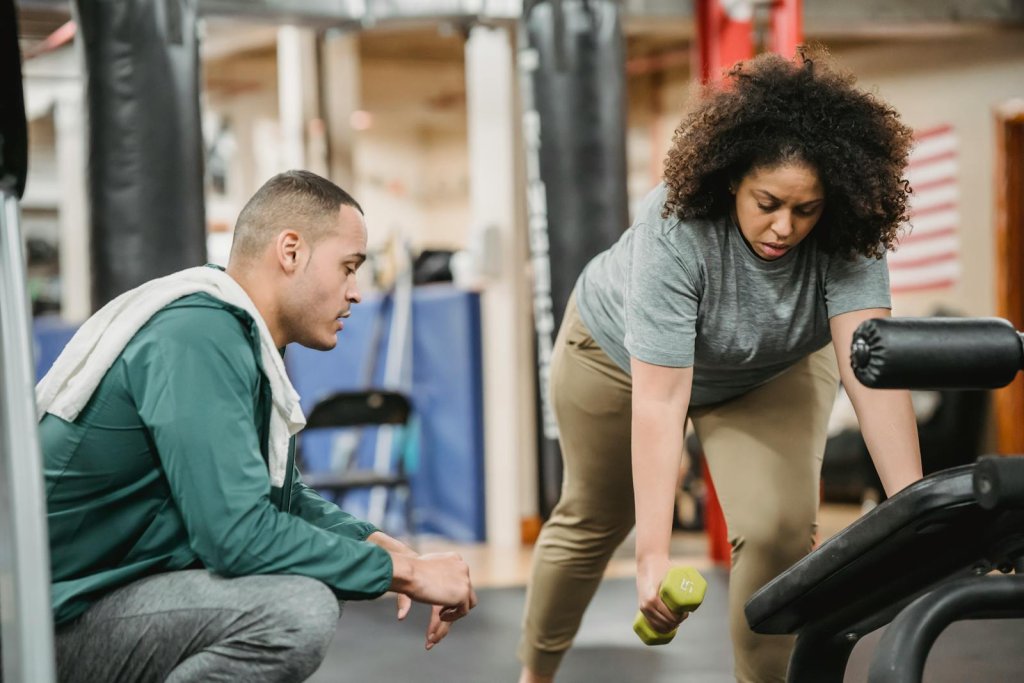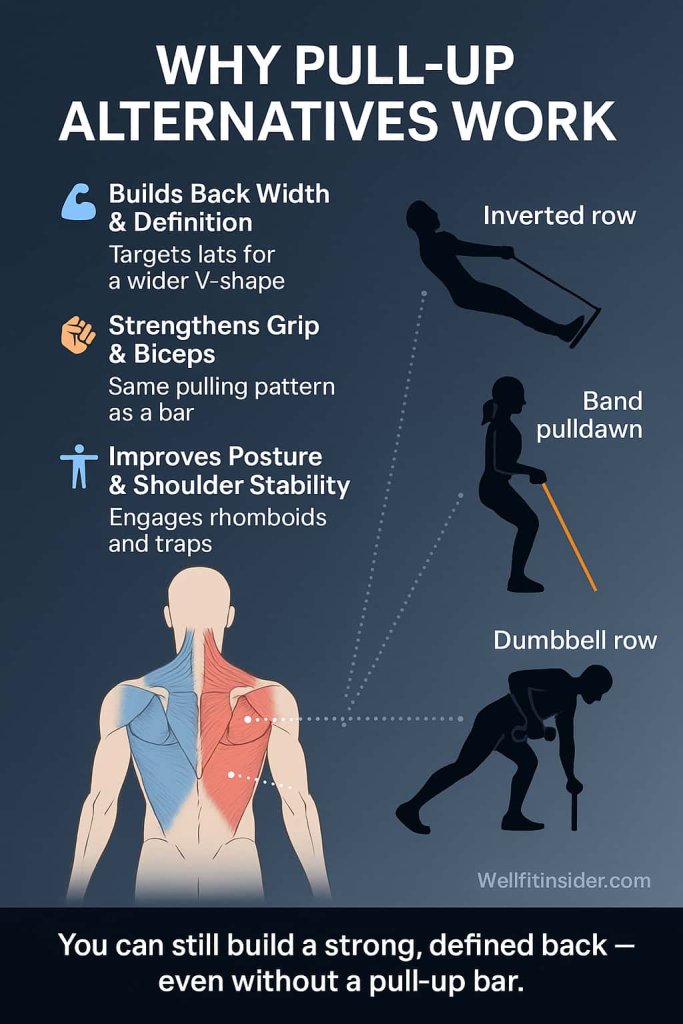Yes — you can build a wide, muscular back even without a pull-up bar.
If you don’t have access to a gym or can’t yet perform a full pull-up, there are powerful alternatives that target the same muscles — your lats, traps, rhomboids, and rear delts — using only dumbbells, bands, or bodyweight.

In this guide, you’ll discover 15 of the best pull-up alternatives for building a thicker, stronger back at home or anywhere. You’ll also learn correct form tips, progressions, and how to get the most out of each move.
Why Pull-Up Alternatives Work
Pull-ups primarily target your latissimus dorsi (the large “V-shape” muscles on your back) along with your biceps, rhomboids, and core.
When you can’t perform pull-ups, you can still mimic the same motion pattern — pulling toward your body against resistance.

Benefits:
- Builds back width and definition
- Strengthens grip and biceps
- Improves posture and shoulder stability
- Can be done anywhere with minimal equipment
15 Best Pull-Up Alternatives
Here are 15 of the most effective pull-up alternatives to help you build a wider, stronger back — no bar required. Each move targets key back muscles like your lats, traps, rhomboids, and biceps, using only bodyweight, dumbbells, or resistance bands. These exercises are perfect for home workouts and ideal for beginners building strength toward their first pull-up.
1. Inverted Row (Bodyweight Row)
Muscles Worked: Lats, mid-back, biceps, core
Why It Works: The inverted row mimics the pull-up’s horizontal pulling pattern, engaging the same back and arm muscles — just from a different angle.
How to Do It:
- Lie underneath a sturdy barbell set at waist height or under a strong table.
- Grab the bar with an overhand grip, hands slightly wider than shoulder-width.
- Keep your body straight from head to heels and pull your chest toward the bar.
- Pause briefly, then lower under control until arms are fully extended.
Trainer Tip: The lower you position your body (more parallel to the floor), the more challenging the move becomes. Keep your core tight and avoid letting your hips sag.
2. Resistance Band Lat Pulldown
Muscles Worked: Lats, biceps, shoulders
Why It Works: This banded version closely replicates the vertical pull of a standard pull-up, effectively targeting your latissimus dorsi.
How to Do It:
- Anchor a resistance band to a high point (like a pull-up bar or door anchor).
- Sit or kneel facing the anchor.
- Grab the handles and pull the band down toward your upper chest.
- Squeeze your shoulder blades together, then return slowly to the start.
Trainer Tip: Use a thicker or double band for higher resistance. Focus on pulling your elbows down and back rather than just your hands.
3. Dumbbell Bent-Over Row
Muscles Worked: Lats, traps, rhomboids, biceps
Why It Works: Builds mid-back thickness and overall pulling strength, a key complement to pull-up performance.
How to Do It:
- Hold a dumbbell in each hand with a neutral grip.
- Bend your knees slightly and hinge forward at the hips until your torso is about 45° to the floor.
- Pull your elbows toward your hips, keeping them close to your body.
- Lower the weights under control.
Trainer Tip: Keep your spine neutral and chest up. Avoid rounding your lower back or jerking the weight.
4. One-Arm Dumbbell Row
Muscles Worked: Lats, rear delts, rhomboids
Why It Works: Trains each side independently, helping correct muscular imbalances common from bilateral lifts.
How to Do It:
- Place one hand and knee on a flat bench.
- Hold a dumbbell in the opposite hand.
- Pull the dumbbell toward your lower ribs, keeping your torso stable.
- Slowly lower the weight until your arm is straight.
Trainer Tip: Don’t twist your torso; keep your shoulders square to the floor. Focus on leading with your elbow, not your hand.
5. Seated Cable or Band Row
Muscles Worked: Lats, traps, rhomboids
Why It Works: Trains scapular retraction — the key movement for strong, stable shoulders.
How to Do It:
- Sit with your legs extended and a resistance band wrapped around your feet.
- Hold the handles and sit tall.
- Pull the bands toward your midsection while keeping elbows close.
- Squeeze shoulder blades together at the end, then release slowly.
Trainer Tip: Keep your chest lifted. Avoid leaning backward — the work should come from your upper back, not momentum.
6. Table Edge Row (Under-Table Pull)
Muscles Worked: Lats, biceps, traps
Why It Works: A convenient at-home alternative requiring no gym equipment.
How to Do It:
- Slide under a sturdy table and grab the edge.
- Keep your body straight with heels on the ground.
- Pull your chest up toward the table.
- Lower yourself slowly until your arms are extended again.
Trainer Tip: Align your chest directly under the table edge for full range of motion. Always test the table for stability first.
7. Renegade Row
Muscles Worked: Lats, core, triceps, shoulders
Why It Works: Combines back and core engagement, improving total-body stability and balance.
How to Do It:
- Get into a push-up position with hands gripping dumbbells.
- Keeping your hips level, row one arm up to your rib cage.
- Lower it slowly, then repeat on the other side.
Trainer Tip: Keep your feet slightly wider apart for better stability. Avoid rotating your torso — let your core do the work.
8. Towel Doorway Row
Muscles Worked: Lats, rear delts, rhomboids
Why It Works: Perfect for home workouts — all you need is a strong towel and a sturdy door.
How to Do It:
- Wrap a thick towel around a closed door handle.
- Lean back with arms extended, keeping your body straight.
- Pull your chest toward the door, squeezing your back muscles.
- Return slowly to the start.
Trainer Tip: Ensure the door opens away from you for safety. Step your feet closer to increase resistance.
9. Dumbbell Pullover
Muscles Worked: Lats, chest, triceps
Why It Works: Expands the rib cage and deeply stretches the lats while building upper-body strength.
How to Do It:
- Lie on a bench or the floor with one dumbbell held above your chest.
- Keeping elbows slightly bent, lower the weight behind your head.
- Feel the stretch in your lats, then bring the weight back over your chest.
Trainer Tip: Use a slow tempo and controlled breathing. Avoid arching your back excessively.
10. Inverted Row (Feet Elevated)
Muscles Worked: Lats, traps, rhomboids
Why It Works: This advanced variation increases resistance and replicates the strength demands of a full pull-up.
How to Do It:
- Perform a standard inverted row but rest your feet on a bench.
- Keep your body rigid and pull your chest to the bar.
- Lower under control without dropping your hips.
Trainer Tip: Maintain a neutral neck and straight spine. Keep the motion smooth and controlled.
11. Prone Superman
Muscles Worked: Erector spinae, glutes, shoulders
Why It Works: Strengthens your spinal stabilizers — essential for posture and pull-up form.
How to Do It:
- Lie face down on the floor with arms extended overhead.
- Simultaneously lift your arms, chest, and legs off the floor.
- Hold for 3 seconds, then lower back down.
Trainer Tip: Focus on engaging your glutes and lower back, not just swinging your limbs.
12. Reverse Snow Angel
Muscles Worked: Lats, rear delts, traps
Why It Works: Improves shoulder mobility and upper-back strength — critical for the pull-up lockout phase.
How to Do It:
- Lie face down with arms by your sides, palms facing down.
- Lift your chest slightly and sweep your arms overhead in a wide arc.
- Return to start position in a controlled motion.
Trainer Tip: Keep movements slow and smooth. Avoid shrugging your shoulders during the sweep.
13. Band Face Pull
Muscles Worked: Rear delts, rhomboids, traps
Why It Works: Reinforces posture and shoulder health, balancing out pressing exercises.
How to Do It:
- Anchor a resistance band at upper-chest height.
- Grip the band with both hands, palms facing down.
- Pull it toward your face with elbows flared outward.
- Squeeze shoulder blades together before returning.
Trainer Tip: Keep the band under control — don’t let it snap back. Maintain tension throughout.
14. Back Widow (Elbow Push-Up)
Muscles Worked: Traps, rhomboids, rear delts
Why It Works: A unique bodyweight move that isolates upper-back muscles without any equipment.
How to Do It:
- Lie on your back, knees bent, and elbows close to your sides.
- Press through your elbows to lift your upper torso off the floor.
- Squeeze your shoulder blades at the top, then lower down.
Trainer Tip: Focus on driving with your back muscles rather than pushing with your triceps.
15. Prone Swimmers
Muscles Worked: Lats, traps, rear delts
Why It Works: Builds muscular endurance and coordination through dynamic full-range motion.
How to Do It:
- Lie face down, arms extended in front of you.
- Lift your chest slightly and alternate raising opposite arm and leg in a swimming motion.
- Perform 10–15 controlled repetitions.
Trainer Tip: Keep the movement fluid and continuous. Breathe steadily to maintain endurance.
Sample Workout Plan (No Bar Needed)
| Day | Focus | Example Exercises |
|---|---|---|
| Day 1 | Back + Core | Inverted Row, Dumbbell Row, Superman |
| Day 2 | Rest or Active Mobility | Yoga, Stretching |
| Day 3 | Pull Emphasis | Resistance Band Pulldown, Renegade Row, Face Pull |
| Day 4 | Rest | |
| Day 5 | Full Body | Table Row, Back Widow, Pullover |
| Day 6–7 | Rest / Light Cardio | Walking, Cycling |
Common Mistakes to Avoid
- Rounding your lower back during rows
- Jerking or swinging for momentum
- Ignoring scapular engagement (keep shoulders back and down)
- Not controlling the eccentric (lowering) phase
FAQs
1. Can I build a big back without pull-ups?
Yes. Consistent resistance training using rows, pullovers, and band pulldowns can effectively develop your back.
2. How many times a week should I train my back?
2–3 times per week with at least one rest day between sessions.
3. Which pull-up alternative is best for beginners?
The inverted row and band pulldown are easiest to start with.
4. Do I need heavy weights to grow my back?
Not necessarily — focus on controlled reps, proper form, and progressive overload.
5. Can I replace pull-ups permanently?
Yes, if you consistently increase resistance and maintain good technique.
6. Are these exercises safe for the lower back?
Yes, as long as you keep your spine neutral and avoid hyperextension.
7. What’s the best at-home combination?
Inverted rows, dumbbell rows, and band face pulls offer a complete at-home back workout.
Conclusion
You don’t need a pull-up bar to get a strong, sculpted back. By mastering these 15 pull-up alternatives, you can achieve powerful results using just your bodyweight, dumbbells, or resistance bands.
Start with easier variations, focus on slow controlled reps, and increase resistance over time — your back will thank you.
👉 Stay consistent, keep your form clean, and your back will grow — no bar required.
